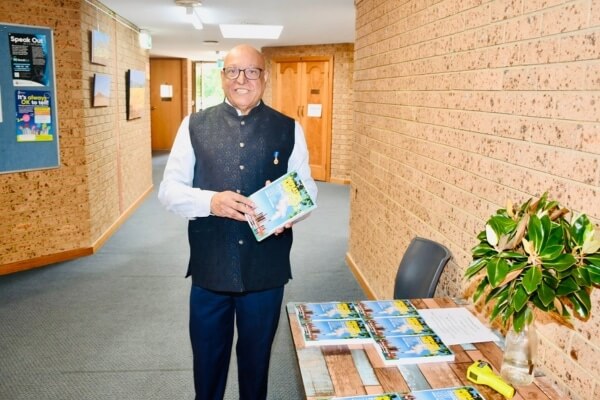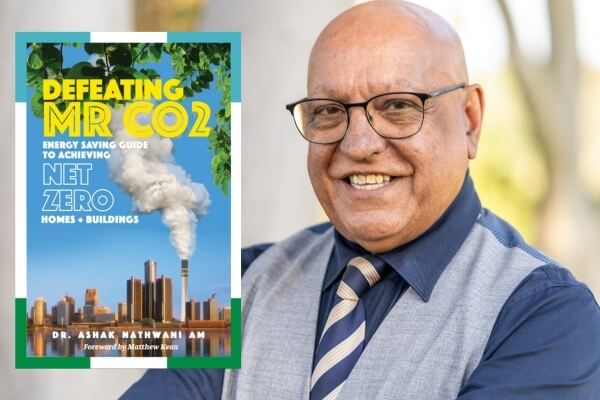Combating climate change requires innovative solutions. A new book by Dr Ashak Nathwani AM, Defeating Mr CO2: Energy Saving Guide to Achieving Net Zero Homes & Buildings, embodies that mission, offering practical strategies for reducing carbon emissions in homes and buildings.
A global expert in energy efficiency and the author of the book, Dr Nathwani tells Indian Link, “It is extremely important that energy consumption and greenhouse gas emissions be minimised in the built environment (residential, commercial and industrial buildings) in the next decade.”
The atmosphere is gasping for breath – and it’s not good news. Greenhouse gas emissions, particularly CO₂ (carbon dioxide), have escalated to record levels that the Earth’s atmosphere is struggling to balance through its natural carbon cycles. This has led to excessive warming of the planet, resulting in extreme weather conditions, and other disturbances in ecosystems worldwide.
Buildings contribute approximately 40% of global carbon emissions, the Sydney-based celebrated engineer adds. In his book, Dr Nathwani provides readers with clear, cost-effective techniques that anyone can implement to reduce energy bills while contributing to a sustainable future.

Ashak Nathwani demonstrates this by using a kettle as an example. Boiling a full kettle when you only need one cup of water uses over double the energy. Just heating one cup can save around 216% in energy each year, and lowering the temperature from 100°C to 80°C reduces it by 24%, Dr Nathwani says.
Another energy-saving tip is to open the refrigerator less frequently so it can cut annual energy usage and thus reduce the compressor’s workload.
Use a clothesline instead of a dryer. Drying clothes on a line like the Hills Hoist (using solar and wind power) can save around $249 annually on drying costs. And finally, use curtains for insulation. Keep the curtains open on sunny winter days for natural warmth, and close them at night to keep warmth in.

“We spend around 90% of our life indoors,” Nathwani explains. “One major misconception is most occupants set the thermostat at 21 degrees Celsius in Summer and 24 degrees Celsius in Winter. It should be the other way around. As you come from outside where there are high temperatures, the summer indoor set-point will give you the required comfort.”
For every degree adjustment in the correct direction, there is a 5% to 7% reduction in the energy bill, he adds.
An era of global boiling
For decades, the scientific community has warned of the dangers of human-induced climate change. In July 2023, United Nations Secretary-General Antonio Guterres called for radical action, saying that record-shattering temperatures that same month show Earth has surpassed the warming phase and entered “an era of global boiling”.
Often, people dismiss the responsibility of combating climate change, assuming it requires sacrificing their comfort. Nathwani’s book, however, challenges this notion, proving that sustainable choices can be practical and comfortable.

“The use of ceiling fans in winter mode with reverse cycle heating is a proven technique to achieve comfort in an energy-efficient manner. The physics behind this is that hot air rises and the ceiling fan in the winter mode will push the air down from ceiling space to occupant level. Saves energy and provides comfort.”
One of the book’s key objectives is to narrow the knowledge gap. It includes case studies from buildings in developed as well as developing nations.
But how do the approaches to energy efficiency differ in developed and developing countries, we ask.
“In developed countries, the level of awareness and understanding of operating heating and cooling systems efficiently in commercial buildings is higher. By the same token, in developing countries, the dedication to sustainability, particularly related to how to save energy bills, is higher – though sometimes at the detriment of indoor comfort.”
In his book, Nathwani has personified carbon emissions as ‘Mr CO2’ in hope that this approach resonates with readers of all age groups.

“The primary intention of personifying the key greenhouse gas as Mr CO2 was to present a concept the reader could identify with,” he says. “Through Mr CO2, various contexts consistently mentioned in the media, such as carbon emissions responsible for global warming, carbon footprint with respect to buildings, carbon sequestration and absorption by trees, etc., could be explained in simple and easy-to-understand terms.”
Advocating energy efficient buildings
Dr Ashak Nathwani arrived in Australia on October 10, 1972, as a political refugee from Uganda, with all but 20 cents and a mechanical engineering degree to his name.
The degree got him into employment in the building services field, specifically air conditioning and refrigeration.
“From the outset of my first job at Honeywell, it became apparent that saving energy was vital,” he recalls. “This became my ethos when I worked with a leading Consulting Engineering firm, Norman Disney Young (NDY), where, within the 33 years
I was there, my role changed from engineering to heading up the sustainability division. After my retirement from NDY, I joined the University of Sydney in 2011 and was appointed Sustainability Director for the master’s degree – High-Performance Building.”

Today, he is internationally known for over five decades of work in promoting energy-efficient buildings and sustainable engineering and facility management practices. Currently, he serves as a Chief Sustainability Officer with Building Zero Consultants.
He is also dedicated to discovering innovative, cost-effective methods to help buildings achieve net zero emissions.
To aspiring architects and engineers interested in sustainable design, Ashak Nathwani advises: “For architects, the message is simple: understand the principles of the heating and cooling systems. On the other hand, engineers need to carry out appropriate calculations and thermal modelling associated with building and building systems at the early stage of new development. They need to work collaboratively with the architect to optimise operations and save energy. The need to minimise the use of glass is fundamental.”





